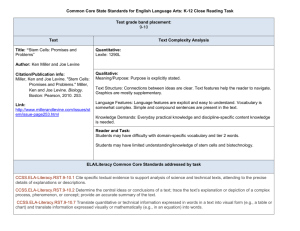Genetic Counseling
advertisement
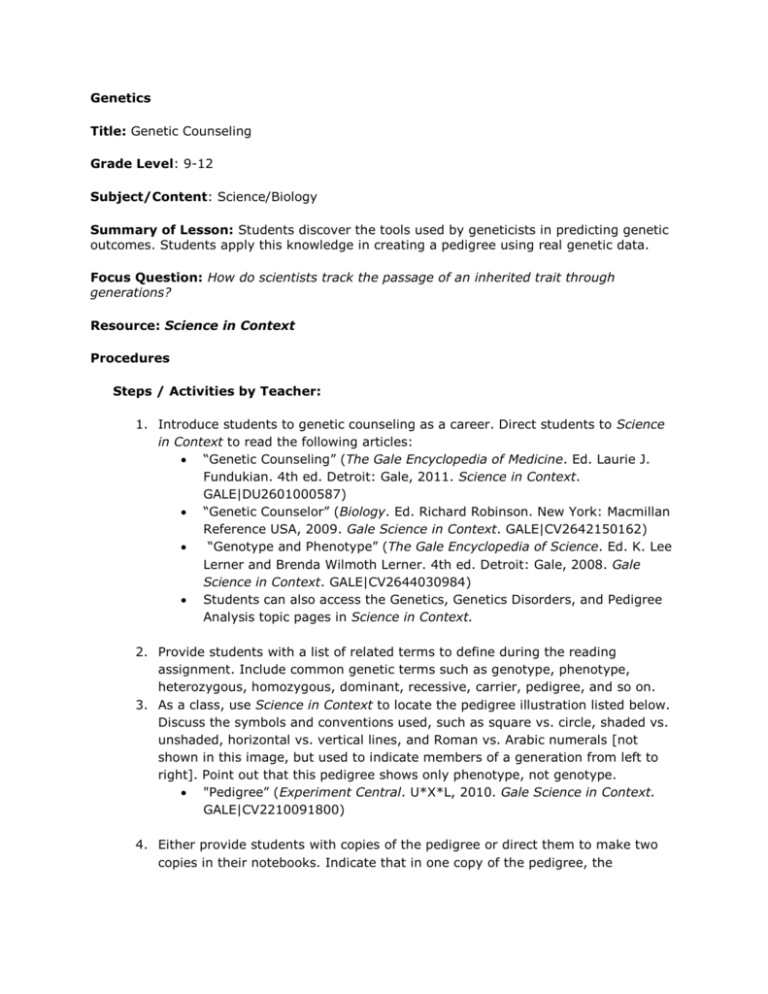
Genetics Title: Genetic Counseling Grade Level: 9-12 Subject/Content: Science/Biology Summary of Lesson: Students discover the tools used by geneticists in predicting genetic outcomes. Students apply this knowledge in creating a pedigree using real genetic data. Focus Question: How do scientists track the passage of an inherited trait through generations? Resource: Science in Context Procedures Steps / Activities by Teacher: 1. Introduce students to genetic counseling as a career. Direct students to Science in Context to read the following articles: “Genetic Counseling” (The Gale Encyclopedia of Medicine. Ed. Laurie J. Fundukian. 4th ed. Detroit: Gale, 2011. Science in Context. GALE|DU2601000587) “Genetic Counselor” (Biology. Ed. Richard Robinson. New York: Macmillan Reference USA, 2009. Gale Science in Context. GALE|CV2642150162) “Genotype and Phenotype” (The Gale Encyclopedia of Science. Ed. K. Lee Lerner and Brenda Wilmoth Lerner. 4th ed. Detroit: Gale, 2008. Gale Science in Context. GALE|CV2644030984) Students can also access the Genetics, Genetics Disorders, and Pedigree Analysis topic pages in Science in Context. 2. Provide students with a list of related terms to define during the reading assignment. Include common genetic terms such as genotype, phenotype, heterozygous, homozygous, dominant, recessive, carrier, pedigree, and so on. 3. As a class, use Science in Context to locate the pedigree illustration listed below. Discuss the symbols and conventions used, such as square vs. circle, shaded vs. unshaded, horizontal vs. vertical lines, and Roman vs. Arabic numerals [not shown in this image, but used to indicate members of a generation from left to right]. Point out that this pedigree shows only phenotype, not genotype. "Pedigree” (Experiment Central. U*X*L, 2010. Gale Science in Context. GALE|CV2210091800) 4. Either provide students with copies of the pedigree or direct them to make two copies in their notebooks. Indicate that in one copy of the pedigree, the phenotype represented by shading is a dominant trait; in the other copy, the phenotype represented by shading is a recessive trait. 5. Pair students up and direct them to work together to create keys for genotype and phenotype (such as in the pedigree shown in the previous article) for each pedigree, and have them further modify the pedigrees to show genotype rather than phenotype. 6. Have students share their pedigrees with the class. Discuss possible differences in results and work with students to correct their work if necessary. 7. Have students access Science in Context to read at least one of the following articles about genetic counseling: “Genetic Testing and Counseling” (World of Health. Gale, 2007. Gale Science in Context. GALE|CV2191500525) “DNA Dilemmas: Readers and ‘Experts’ Weigh in on Biomedical Ethics” (Fackelmann, Kathy A. Science News 17 Dec. 1994: 408+. Gale Science in Context. GALE|A16027241) “Genetic Counseling” (The Gale Encyclopedia of Medicine. Ed. Laurie J. Fundukian. 4th ed. Detroit: Gale, 2011. Science in Context. GALE|DU2601000587) 8. Present students with the following scenario; have them work individually or in pairs to create a pedigree for this couple and to predict the chances that their next child will have the disorder. A couple comes to you for genetic counseling. The couple previously had a daughter who died of infantile Tay-Sachs disease (TSD). They are considering another child, but want to determine the chances that any additional children will have TSD. The man has a first cousin (the son of his father’s sister) who also had a child with this disorder. The woman does not know of anyone in her family with TSD. 9. After students have created their pedigrees, have them write a paragraph describing what they would tell the couple. (Note that genetic counselors do not advise couples as to whether they should or should not have children, but rather provide the information needed to make an informed decision.) Steps/Activities by Students: 1. Access Science in Context and read the assigned articles. 2. As you complete the reading assignment, define the list of related terms provided by your teacher. 3. Discuss the symbols and conventions used in a pedigree. 4. Modify two pedigrees, one for a dominant trait and one for a recessive trait. Discuss. 5. Access Science in Context and read at least one of the following articles: “Genetic Testing and Counseling” (World of Health. Gale, 2007. Gale Science in Context. GALE|CV2191500525) “DNA Dilemmas: Readers and ‘Experts’ Weigh in on Biomedical Ethics” (Fackelmann, Kathy A. Science News 17 Dec. 1994: 408+. Gale Science in Context. GALE|A16027241) “Genetic Counseling” (The Gale Encyclopedia of Medicine. Ed. Laurie J. Fundukian. 4th ed. Detroit: Gale, 2011. Science in Context. GALE|DU2601000587) 6. Create a pedigree for a fictional couple to predict the chances that their next child will have a particular disorder. 7. Write a paragraph describing what you would tell the couple as a genetic counselor. Outcome Students understand the importance of tracing genetically inherited characteristics. They learn to interpret and construct a pedigree. Related Activities Math/Science Discuss probability; students work through the statistical probability of various inheritance patterns. English Students write a paper on genetic counseling as a career choice, exploring some of the ethical dilemmas that might be presented in the course of this work. Standards Alignment Next Generation Science Standards HS-LS1.CNS.1.1. Scientific inquiry is characterized by a common set of values that include: logical thinking, precision, open-mindedness, objectivity, skepticism, replicability of results, and honest and ethical reporting of findings. (HS-LS1-3) LS1.DCI.A:1. All cells contain genetic information in the form of DNA molecules. Genes are regions in the DNA that contain the instructions that code for the formation of proteins. (secondary to HS-LS3-1) (Note: This Disciplinary Core Idea is also addressed by HS-LS1-1.) LS1.DCI.A:2. All cells contain genetic information in the form of DNA molecules. Genes are regions in the DNA that contain the instructions that code for the formation of proteins, which carry out most of the work of cells. (HS-LS1-1) (Note: This Disciplinary Core Idea is also addressed by HS-LS3-1.) HS-LS3-1. Ask questions to clarify relationships about the role of DNA and chromosomes in coding the instructions for characteristic traits passed from parents to offspring. HS-LS3-3. Apply concepts of statistics and probability to explain the variation and distribution of expressed traits in a population. HS-LS3.SEP.2.1. Apply concepts of statistics and probability (including determining function fits to data, slope, intercept, and correlation coefficient for linear fits) to scientific and engineering questions and problems, using digital tools when feasible. (HS-LS3-3) LS3.DCI.B:1. In sexual reproduction, chromosomes can sometimes swap sections during the process of meiosis (cell division), thereby creating new genetic combinations and thus more genetic variation. Although DNA replication is tightly regulated and remarkably accurate, errors do occur and result in mutations, which are also a source of genetic variation. Environmental factors can also cause mutations in genes, and viable mutations are inherited. (HS-LS3-2) LS3.DCI.B:2. Environmental factors also affect expression of traits, and hence affect the probability of occurrences of traits in a population. Thus the variation and distribution of traits observed depends on both genetic and environmental factors. (HS-LS3-2), (HS-LS33) HS-LS4-3. Apply concepts of statistics and probability to support explanations that organisms with an advantageous heritable trait tend to increase in proportion to organisms lacking this trait. Standard Source: Next Generation Science Standards (2013) Common Core State Standards Grades 9-10 CCSS.ELA-Literacy.RST.9-10.2 Determine the central ideas or conclusions of a text; trace the text's explanation or depiction of a complex process, phenomenon, or concept; provide an accurate summary of the text. CCSS.ELA-Literacy.RST.9-10.3 Follow precisely a complex multistep procedure when carrying out experiments, taking measurements, or performing technical tasks attending to special cases or exceptions defined in the text. CCSS.ELA-Literacy.RST.9-10.4 Determine the meaning of symbols, key terms, and other domain-specific words and phrases as they are used in a specific scientific or technical context relevant to grades 9-10 texts and topics. CCSS.ELA-Literacy.RST.9-10.5 Analyze the structure of the relationships among concepts in a text, including relationships among key terms (e.g., force, friction, reaction force, energy). CCSS.ELA-Literacy.RST.9-10.7 Translate quantitative or technical information expressed in words in a text into visual form (e.g., a table or chart) and translate information expressed visually or mathematically (e.g., in an equation) into words. CCSS.ELA-Literacy.RST.9-10.9 Compare and contrast findings presented in a text to those from other sources (including their own experiments), noting when the findings support or contradict previous explanations or accounts. CCSS.ELA-Literacy.RST.9-10.10 By the end of grade 10, read and comprehend science/technical texts in the grades 9-10 text complexity band independently and proficiently. CCSS.ELA-Literacy.WHST.9-10.4 Produce clear and coherent writing in which the development, organization, and style are appropriate to task, purpose, and audience. CCSS.ELA-Literacy.WHST.9-10.6 Use technology, including the Internet, to produce, publish, and update individual or shared writing products, taking advantage of technology's capacity to link to other information and to display information flexibly and dynamically. CCSS.ELA-Literacy.WHST.9-10.7 Conduct short, as well as more sustained research projects, to answer a question (including a self-generated question) or solve a problem; narrow or broaden the inquiry when appropriate; synthesize multiple sources on the subject, demonstrating understanding of the subject under investigation. CCSS.ELA-Literacy.WHST.9-10.8 Gather relevant information from multiple authoritative print and digital sources, using advanced searches effectively; assess the usefulness of each source in answering the research question; integrate information into the text selectively to maintain the flow of ideas, avoiding plagiarism and following a standard format for citation. CCSS.ELA-Literacy.WHST.9-10.9 analysis, reflection, and research. Draw evidence from informational texts to support CCSS.ELA-Literacy.WHST.9-10.10 Write routinely over extended time frames (time for reflection and revision) and shorter time frames (a single sitting or a day or two) for a range of discipline-specific tasks, purposes, and audiences. Grades 11-12 CCSS.ELA-Literacy.RST.11-12.2 Determine the central ideas or conclusions of a text; summarize complex concepts, processes, or information presented in a text by paraphrasing them in simpler but still accurate terms. CCSS.ELA-Literacy.RST.11-12.3 Follow precisely a complex multistep procedure when carrying out experiments, taking measurements, or performing technical tasks; analyze the specific results based on explanations in the text. CCSS.ELA-Literacy.RST.11-12.4 Determine the meaning of symbols, key terms, and other domain-specific words and phrases as they are used in a specific scientific or technical context relevant to grades 11-12 texts and topics. CCSS.ELA-Literacy.RST.11-12.5 Analyze how the text structures information or ideas into categories or hierarchies, demonstrating understanding of the information or ideas. CCSS.ELA-Literacy.RST.11-12.7 Integrate and evaluate multiple sources of information presented in diverse formats and media (e.g., quantitative data, video, multimedia) in order to address a question or solve a problem. CCSS.ELA-Literacy.RST.11-12.8 Evaluate the hypotheses, data, analysis, and conclusions in a science or technical text, verifying the data when possible and corroborating or challenging conclusions with other sources of information. CCSS.ELA-Literacy.RST.11-12.9 Synthesize information from a range of sources (e.g., texts, experiments, simulations) into a coherent understanding of a process, phenomenon, or concept, resolving conflicting information when possible. CCSS.ELA-Literacy.RST.11-12.10 By the end of grade 12, read and comprehend science/technical texts in the grades 11-12 text complexity band independently and proficiently. CCSS.ELA-Literacy.WHST.11-12.2a Introduce a topic and organize complex ideas, concepts, and information so that each new element builds on that which precedes it to create a unified whole; include formatting (e.g., headings), graphics (e.g., figures, tables), and multimedia when useful to aiding comprehension. CCSS.ELA-Literacy.WHST.11-12.2b Develop the topic thoroughly by selecting the most significant and relevant facts, extended definitions, concrete details, quotations, or other information and examples appropriate to the audience's knowledge of the topic. CCSS.ELA-Literacy.WHST.11-12.4 Produce clear and coherent writing in which the development, organization, and style are appropriate to task, purpose, and audience. CCSS.ELA-Literacy.WHST.11-12.6 Use technology, including the Internet, to produce, publish, and update individual or shared writing products in response to ongoing feedback, including new arguments or information. CCSS.ELA-Literacy.WHST.11-12.7 Conduct short, as well as more sustained research projects, to answer a question (including a self-generated question) or solve a problem; narrow or broaden the inquiry when appropriate; synthesize multiple sources on the subject, demonstrating understanding of the subject under investigation. CCSS.ELA-Literacy.WHST.11-12.8 Gather relevant information from multiple authoritative print and digital sources, using advanced searches effectively; assess the strengths and limitations of each source in terms of the specific task, purpose, and audience; integrate information into the text selectively to maintain the flow of ideas, avoiding plagiarism and overreliance on any one source and following a standard format for citation. CCSS.ELA-Literacy.WHST.11-12.9 Draw evidence from informational texts to support analysis, reflection, and research. CCSS.ELA-Literacy.WHST.11-12.10 Write routinely over extended time frames (time for reflection and revision) and shorter time frames (a single sitting or a day or two) for a range of discipline-specific tasks, purposes, and audiences. Source: Common Core State Standards Initiative (2010)



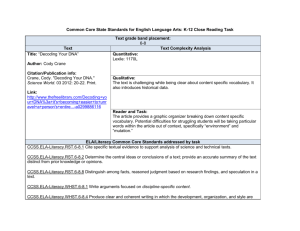
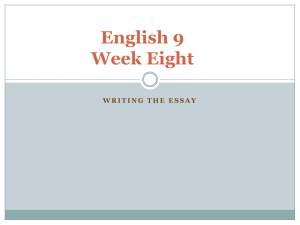
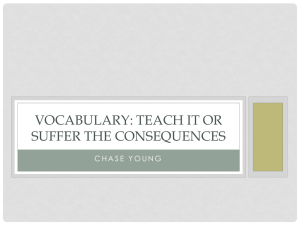
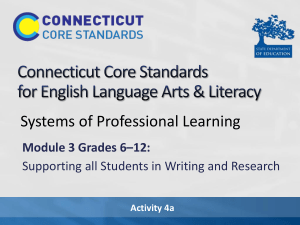
![iPads_and_Writing_2013[1]](http://s2.studylib.net/store/data/005383991_1-1bc8c0f2382c2ccb89e094c534f531f0-300x300.png)
